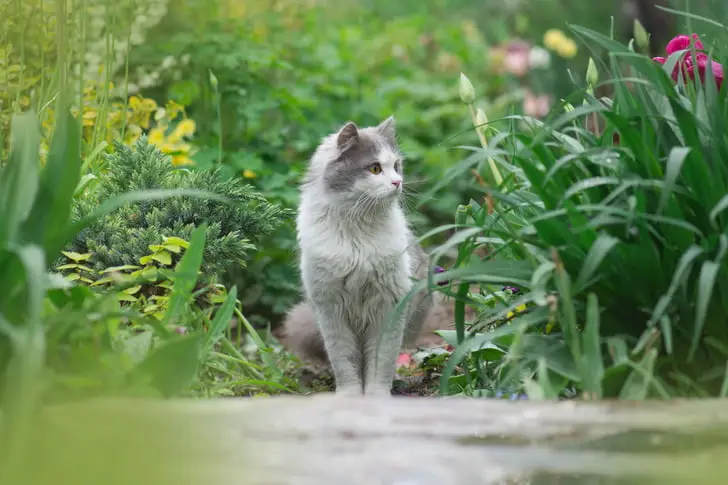Cats are among the most popular pets, but not everyone likes having strange cats in their garden – and certainly not their droppings in the flowerbeds. Instead of resorting to cat repellents with loud noises, read here about which pet-friendly tricks you can use to deter cats.
Whether in vegetable or flower beds, it’s not pleasant when cats do their business in your garden.
Fortunately, there are many pet-friendly methods to repel cats and keep them away from your garden.
Natural Cat Deterrents
Cats are very intelligent and strong-willed. To repel a cat, you need to make the path or stay in the garden or flowerbeds so unattractive that the cat decides on its own not to relieve itself in your garden anymore.

For example, certain plants are suitable as cat deterrents.
- Mint, lemongrass, rosemary, and the “Get lost” plant (botanical name: Plectranthus ornatus) have scents that are unpleasant for cats. Planted throughout the garden, they can serve as cat repellents.
- Additionally, you can scatter coffee grounds or peeled garlic cloves to keep cats away from your beds.
- Spices with strong scents such as pepper or cloves have also proven effective as cat repellents.
Make Your Own Cat Repellent Spray
You can also make your own cat repellent spray that drives away the culprits with its smell. For this you need:
- 100 milliliters of liquid soap
- 100 milliliters of apple cider vinegar
- 100 milliliters of water
Place all ingredients in a spray bottle and shake to thoroughly mix the ingredients. Spray it on stones, soil, and decorations in the garden area from which you want to repel the cats.
Tip: Be careful not to spray directly on your plants and preferably use organic soap. Anything else could harm your plants.
Alternatively, you can simply add a few drops of essential oil to a spray bottle with water and shake well. This cat repellent spray is also suitable for indoor use. Suitable oils include:
- Mint
- Lavender
- Lemon
- Cinnamon
- Rosemary
Regardless of which repellent spray you choose – always test the mixture first in an inconspicuous spot to see if the spray damages your plants or – if you use it indoors – leaves stains on furniture or floors.
Pet-Friendly Cat Deterrents for Garden Beds and Flower Pots
If a cat has already become accustomed to using your garden beds and planters as a litter box, it’s difficult to break the habit. However, one reliable method against cats in the garden is to make digging in the soil more difficult.

- Cats prefer beds and pots with dry, loose soil. To repel cats in a pet-friendly way, it may be enough to cover the soil in the bed with mulch or pine cones. These materials are not easily dug up and don’t have the consistency that cats prefer. Additionally, the soil in the bed stays moist longer and weeds can’t regrow, which also benefits your plants.
- Another option is to place obstacles in the soil of the beds that prevent cats from digging. Wooden or metal rods are particularly suitable, which you can simply place between the plants and on the soil.
- Immediately after sowing, you can also place a wire mesh, such as rabbit wire*, on the bed to prevent cats from using the still bare bed as a toilet.
To protect your flower pots, it has proven effective to block the cat’s access to the soil. You can place large stones in the flower pot or cut plant protection grids from rabbit wire* yourself or purchase them.
Cat Deterrence with Hawthorn Hedges
If you want to prevent neighboring cats from entering your garden at all, a hawthorn hedge is the first choice: The dense growth and thorns make it very uncomfortable for cats to pass through, yet the plant is non-toxic to cats.
Furthermore, birds, hedgehogs, and other garden inhabitants appreciate the additional nesting opportunities and hiding places.
By the way: Hawthorn blossoms are an important food source for wild bees and other insects in spring.
Cat Deterrence with Cat Repellent Devices
In severe cases, or if all the home remedies for cat deterrence listed above have not worked, you can also find commercial products to repel cats.
Many manufacturers offer ultrasonic devices* as cat repellents that drive cats away with unpleasant sounds.
Scented clay granules* that repel cats through smell are also available commercially.
Water as Cat Deterrent
A widely circulated piece of advice is to spray water on the cat with a spray bottle or water gun when it starts to relieve itself in the beds or on the lawn.
However, this method is not productive, as cats quickly learn that the water spray is connected to human presence. This can damage the relationship with your own cat and unsettle the animal. It’s better to investigate the causes and make the litter box attractive to the cat again.
Fundamentally, cats are very clean animals that like to keep their territory clean. So if your cat has chosen the garden as a toilet, you should first check what is causing this behavior.
Perhaps the litter box is in a place where the cat can’t find peace and feels vulnerable. It could also be that the litter box is too small or the cat finds the cat litter uncomfortable.
You can gently and humanely repel cats in the garden using home remedies, plants, and scents, without immediately resorting to ultrasonic cat repellent devices.
